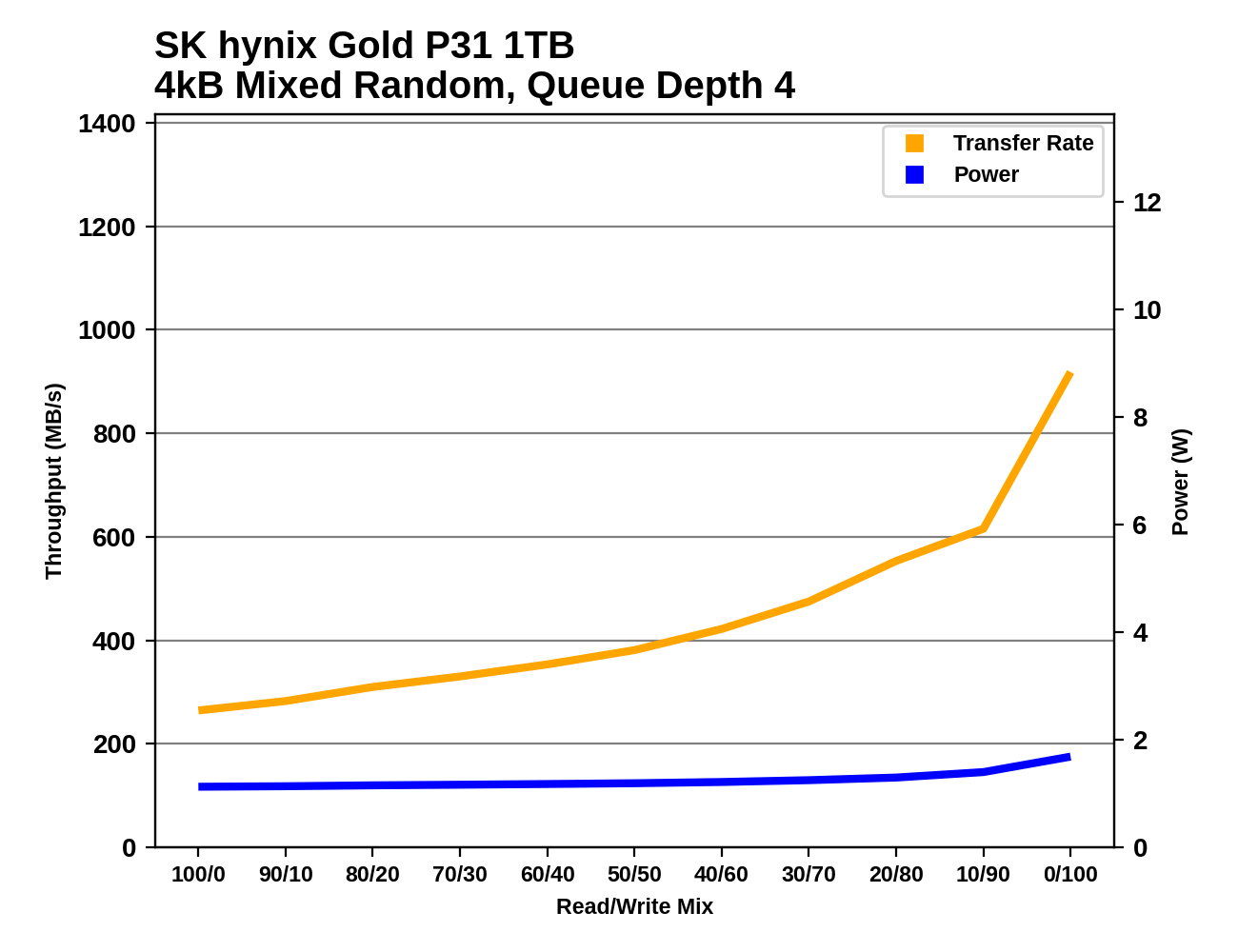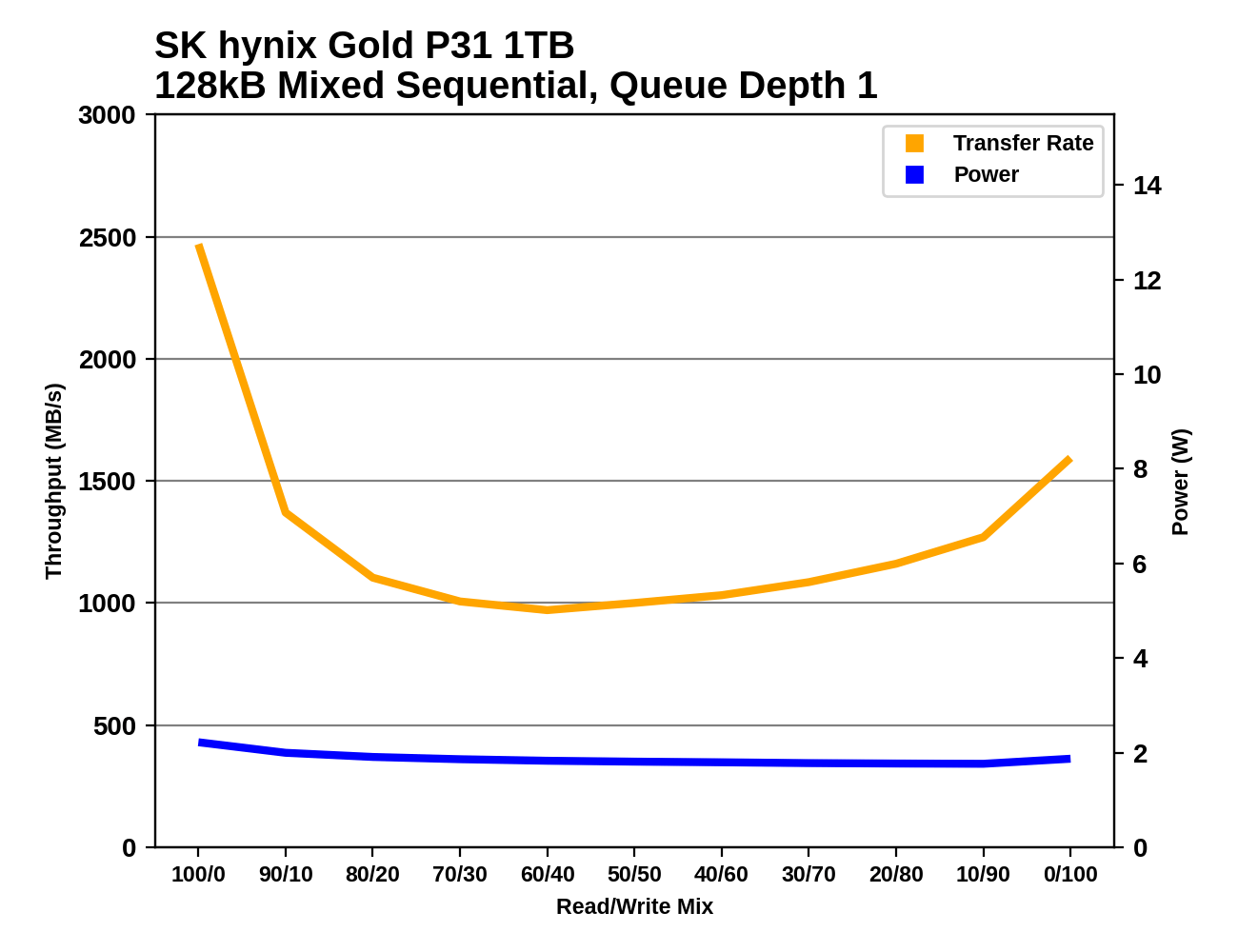The Best NVMe SSD for Laptops and Notebooks: SK hynix Gold P31 1TB SSD Reviewed
by Billy Tallis on August 27, 2020 8:00 AM ESTMixed Random Performance
Our test of mixed random reads and writes covers mixes varying from pure reads to pure writes at 10% increments. Each mix is tested for up to 1 minute or 32GB of data transferred. The test is conducted with a queue depth of 4, and is limited to a 64GB span of the drive. In between each mix, the drive is given idle time of up to one minute so that the overall duty cycle is 50%.

The Intel Optane 905P holds on to a very comfortable performance lead on our mixed random IO test, but the SK hynix Gold P31 raises the bar for TLC-based SSDs by about 10%.
 |
|||||||||
| Power Efficiency in MB/s/W | Average Power in W | ||||||||
The Gold P31 has the lowest average power consumption on this test out of all the drives in this batch, which naturally leads to a massive lead in power efficiency: it delivers twice the performance per Watt of the next best drive.
 |
|||||||||
Compared to other high-end TLC-based SSDs, the Gold P31 performs best during the more read-heavy phases of this test. Several competitors catch up to it and a few surpass it during the most write-intensive portions of the test, but that also tends to be where the P31's power usage advantage is widest.
Mixed Sequential Performance
Our test of mixed sequential reads and writes differs from the mixed random I/O test by performing 128kB sequential accesses rather than 4kB accesses at random locations, and the sequential test is conducted at queue depth 1. The range of mixes tested is the same, and the timing and limits on data transfers are also the same as above.

The mixed sequential read/write performance of the SK hynix Gold P31 is unimpressive. For once, its performance is about what we'd expect from a drive designed more for efficiency than raw performance. However, it still has an 18% lead over the slowest 8-channel drive in this batch.
 |
|||||||||
| Power Efficiency in MB/s/W | Average Power in W | ||||||||
The Gold P31 still completes this test with remarkably low power consumption (averaging less than 2W), but the relatively modest performance means its efficiency score is only about 33% above the next best drive in this bunch.
 |
|||||||||
After starting out with a good sequential read speed, the SK hynix Gold P31's performance drops steeply when writes are added to the mix. It bottoms out just below 1GB/s with a 60% reads mix, and then gradually recovers performance to finish with a fairly typical sequential write speed. Power consumption from the P31 doesn't vary much across the test, and it's only above 2W at the very beginning of the test.










80 Comments
View All Comments
Luminar - Tuesday, September 1, 2020 - link
Kapton tape works better. Those small SSDs can get pretty hot and good Kapton tape won't leave residue.Luminar - Thursday, August 27, 2020 - link
Why didn't the WD blue sn500 get included?Billy Tallis - Thursday, August 27, 2020 - link
Mainly because I only have a 250GB sample of that, and that's not a particularly fair or relevant comparison against 1TB drives. If I had the 1TB SN550 I would definitely have included that.cfbcfb - Sunday, August 30, 2020 - link
Not even in the ballpark. The read and especially write speeds are in the top 3 of ALL nvme SSD's, and this one uses half the power and makes half the heat, for just a few dollars more than the Blue. In fact, in most use cases, its faster than the WD Black for less money.DZor - Thursday, August 27, 2020 - link
All this does not matter cause 1TB drives are for long time in USD 130 - 150 range. For PCIe 3. PCIe 4 is some USD 50 more expensive.Except for "hi end" once like 970 Pro.
Gigaplex - Thursday, August 27, 2020 - link
Why doesn't it matter? It's a good drive in this price range, and to many people it's pretty affordable.plopke - Thursday, August 27, 2020 - link
I am curious to try SKHynix consumer drives out myself. But unless you are a OEM like dell there is no support software to check firmware or update firmware , so if there is ever an issues they have no framework at all to fix anything? This drive isn't even mentioned on their weird ssd webpage?I mean sandisk-WD/samsung/crucial/ADATA/Kingston , ALL OF THEM have a ssd manager client and software in place just in case firmware updates are needed?
plopke - Thursday, August 27, 2020 - link
PS I mean someone please proof me wrong , i actually was kinda interested in getting one of these but then I saw their product page and it was horrible and alarms bells started to ring when I couldn't find any support software at all.Billy Tallis - Thursday, August 27, 2020 - link
Their consumer SSD site is definitely a work in progress, but that's not too surprising since they only have two retail products at the moment and no real history in this market.I wouldn't be too worried about software. Aside from firmware updates, there's really not much point in vendor-specific tools and I wish they would all just lobby Microsoft to make decent vendor-neutral storage admin tools.
And I don't think firmware updates are as important as you seem to think. They're pretty uncommon these days and usually don't matter much unless your system has a weird incompatibility that a SSD firmware update can fix. If SK hynix does need to push out an update for this drive, I'm sure they'll be able to come up with a delivery method. Running an extra application to give you a firmware update notification on the outside chance you ever need such a notification is a bit silly.
damianrobertjones - Thursday, August 27, 2020 - link
Well, I'm not a copy editor, but i could prove you wrong if I tried.